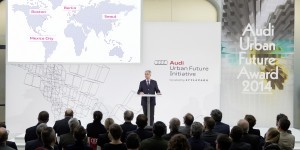Auto
More space and better quality of life in cities: Audi introduces the “Urban Agenda”
-
Networked mobility in mega-cities will be a key market for Audi
-
Audi CEO Stadler announces development partnerships with cities
-
Automobile innovations reduce the space required by individual traffic
 Audi CEO Rupert Stadler presented the cornerstones of his “Urban Agenda” on Monday, announcing that networked mobility technologies for the mega-cities of tomorrow will be a key market. At the presentation of the Audi Urban Future Award 2014 in Berlin, executive board chairman Stadler said: “If we succeed in decoding the DNA of mobility, the city will become predictable.” Then it would be possible to avoid traffic congestion and to enhance the quality of life. Digitalization would then bring about a new cooperation of the car and the city. Audi therefore plans to grasp this “once-in-a-century opportunity” by using new technologies to improve the flow of information between cars and urban infrastructure. Stadler announced worldwide development partnerships with major cities.
Audi CEO Rupert Stadler presented the cornerstones of his “Urban Agenda” on Monday, announcing that networked mobility technologies for the mega-cities of tomorrow will be a key market. At the presentation of the Audi Urban Future Award 2014 in Berlin, executive board chairman Stadler said: “If we succeed in decoding the DNA of mobility, the city will become predictable.” Then it would be possible to avoid traffic congestion and to enhance the quality of life. Digitalization would then bring about a new cooperation of the car and the city. Audi therefore plans to grasp this “once-in-a-century opportunity” by using new technologies to improve the flow of information between cars and urban infrastructure. Stadler announced worldwide development partnerships with major cities.
“The car has to be seen once again as a desirable object of progress,” Stadler demanded. “To achieve this, we have to tear down the walls between infrastructure, public transportation and individual traffic. For example, traffic lights and cars will communicate with each other in future – in Berlin one in three traffic lights is already compatible with this technology.“
More than half of humanity already lives in cities, and in 2050 the proportion will be approximately 70 percent. 75 percent of global added value will be generated there. “The metropolitan regions of the world are our growth markets. We will develop products and solutions that make mobility in cities attractive again and enhance the quality of life,“ said Stadler.
A decline in individual traffic in cities is not to be expected: the figures for new vehicle registration in the world’s growth regions are growing continuously. Audi sets its sights on solutions in which individual transportation makes a positive contribution in an overall system of different forms of mobility. In the framework of its Urban Agenda, the company is therefore pursuing the aim of reducing the space needed in cities by individual traffic through networked automobile technologies. At the same time there will be time savings and a higher quality of urban experience.
New technologies such as Audi’s parking garage pilot are ready for the market, and create new free space for city planning. The parking surface required shrinks by two square meters per car if the car autonomously parks itself. In this way parking garages can accommodate two and a half times more cars on the area. Assistance systems that optimize the traffic flow ensure time savings and a higher-quality experience. The driver has to brake sharply less often, is helped to change lanes and knows the perfect speed to get a “green wave” at traffic lights. The “traffic-light information online” service networks the automobile with the central traffic management computer that controls the traffic lights in the city. This reduces CO2 emissions by up to 15 percent. Car-to-x and car-to-car communication makes better use of the roads’ capacity.
Development partnerships with cities
The core of Audi’s Urban Agenda are development partnerships that take pinpointed urban system solutions into cities. “We have a responsibility for the problems that the car causes in mega-cities today, and will take an active part in solving these problems by means of our development work. To do this, we need local government, project developers and industry to work together,” commented Stadler.
The Audi Urban Future Initiative, which was established in 2010, stimulates international dialog with urban planners, architects and mobility experts. In the framework of the Audi Urban Future Award 2014, four interdisciplinary teams from Berlin, Boston, Mexico City and Seoul have produced new mobility ideas under the motto “the next leap in mobility”, taking account of urban planning, social and technological questions. In Berlin, city planners, architects, data experts and designers presented to the public their solutions to current urban planning projects. With its Urban Agenda, Audi builds directly on the insights gained in this year’s Award.
Urban Future Partnerships (UFPs) with metropolitan regions and local authorities world-wide are planned. On the basis of specific construction and transportation projects, Audi is promoting the networking of automobile technologies development partners from cities and the real-estate business. “Our ambitions don’t stop at the car – they include its surroundings. Urban solutions will be an decisive business factor for us. If “Vorsprung durch Technik” leads to a better experience of urban life for our customers, we will have achieved our goal of success that is sustainable in every way,” said Stadler.



















































